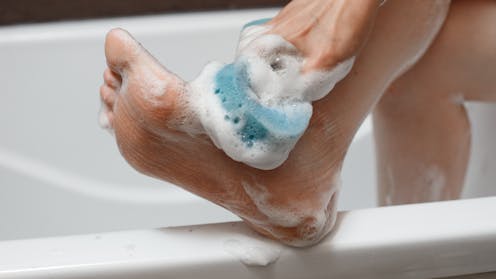From athlete’s foot to smelly soles: why daily washing is key to healthy feet
Washing your feet might not top your list of daily priorities – but it should.
While most of us shower regularly, our feet are often forgotten. Letting water run over them isn’t enough. To keep them healthy, you need to actively wash your feet with soap and water, paying close attention to the soles and the spaces between your toes. This helps remove sweat, dead skin and microbes that build up throughout the day and helps prevent infections, irritation – and that all-too-familiar smell.
Feet, particularly the spaces between toes, are a breeding ground for bacteria and fungi. Thanks to socks, shoes, and sweaty soles, they spend most of the day in a warm, humid environment that’s perfect for microbial growth. This can lead to common conditions like athlete’s foot, fungal nail infections, and bromodosis (smelly feet).
Stinky feet
Sweat itself doesn’t smell. But when bacteria break down sweat on your feet, they release smelly compounds called volatile fatty acids (VFAs). Staphylococcus bacteria are key players here, feeding on amino acids in sweat and producing isovaleric acid, which smells distinctly cheesy or sour (fun fact: it’s the same compound found in certain cheeses).
A study found that 98.6% of bacteria on the soles of participants’ feet were Staphylococci, and the intensity of foot odour was directly linked to how much of this bacteria was present.
Good foot hygiene isn’t just about avoiding odour, though; it also helps prevent infections. Athlete’s foot, a fungal infection, thrives in the damp space between your toes. It causes itching, redness, cracked skin and sometimes blisters. And despite the name, you don’t have to be an athlete to get it. The infection spreads easily in communal places like swimming pools, showers and changing rooms, particularly if you go barefoot.
If left untreated, the fungus can spread to the toenails, making them thick, yellow and brittle. Catching it early makes treatment much easier.
Read more:
Fighting fungal nail infections: simple steps for healthier toenails
Bacterial infections are also a concern, especially when Staphylococcus or Pseudomonas enter through small cuts or cracked skin. Washing regularly helps reduce the number of bacteria living on the surface, lowering the risk of infection for anyone with vulnerable or damaged skin.
Diabetic foot care
If you have diabetes, foot care becomes even more important. People with diabetes are more prone to ulcers and infections and wounds often heal more slowly, particularly when blood sugar levels are poorly controlled.
Read more:
Five ways to save your legs – by a vascular surgery specialist
This is due to several factors: poor circulation means less oxygen and fewer nutrients reach the site of the wound, the immune response is weaker, and inflammation may persist. Nerve damage (diabetic neuropathy) in the feet can also mean that injuries go unnoticed – and untreated.
According to Diabetes UK, daily foot washing is a key part of diabetes care; not just to reduce infection risk, but to check for any early signs of damage, such as redness, swelling, or breaks in the skin.
Too clean?
If you’ve been in closed shoes all day, or exercising, a proper wash is a good idea. For most people, once a day is enough, particularly during warm weather.
But not everyone needs to scrub their feet daily. The skin is home to a healthy community of beneficial microbes that defend against harmful bacteria and support the skin’s natural barrier. Overwashing, particularly with hot water or harsh soaps, can strip these helpful organisms and remove natural oils, leaving skin dry, irritated and more prone to cracking.
This is especially problematic for people with skin conditions like eczema where the skin barrier is already weakened.
The use of antibacterial soaps can also disrupt the skin’s microbial balance, killing off friendly bacteria and potentially encouraging the growth of more harmful, antibiotic-resistant strains. Some scientists also suggest that excessive hygiene might reduce the immune system’s exposure to everyday microbes; exposure that helps build a healthy immune response.
How to wash your feet properly
Here’s how to do it right, according to NHS guidance:
use warm (not hot) water and a mild soap
wash thoroughly, paying close attention to the soles and between the toes
dry your feet completely, including the spaces between your toes
apply moisturiser to keep the skin soft and less likely to crack — but skip the areas between the toes, as added moisture there can encourage fungal growth
inspect your feet regularly for any signs of redness, swelling, or blisters — vital for those with diabetes.
If you notice persistent itching, unusual odours, or signs of infection, speak to a pharmacist. They can recommend over-the-counter treatments or refer you to a podiatrist if necessary.
Whether you’re active, managing a chronic condition, or just trying to stay fresh in summer, proper foot hygiene matters. It might seem like a small step – but it makes a big difference to your overall health.
Dipa Kamdar does not work for, consult, own shares in or receive funding from any company or organisation that would benefit from this article, and has disclosed no relevant affiliations beyond their academic appointment.



